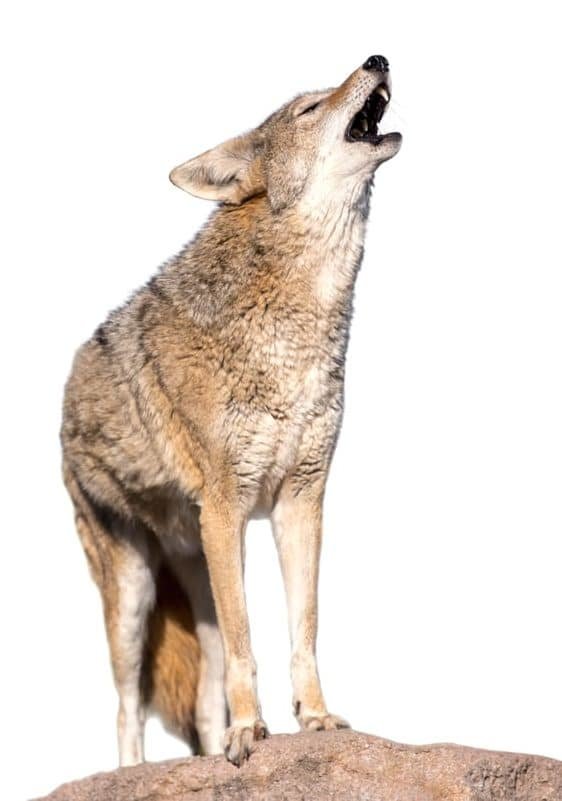
Coyotes are singing on the peninsula. They wake me in the wee hours. My mind needs a good minute or two to figure out if the eerie sounds belong to my dreamworld or the woods outside. Does our language have words for such song? Wolves howl. Owls hoot. Dogs bark or bay or yowl. But coyotes yip and chatter and scream with such a crazed laughter that it seems to come from all directions at once.
Coyotes are singing, circulating, appearing and disappearing. Is there any other animal that plays on our nerves like coyotes? Maybe crows. Recently I came across a coyote on a forest trail near some houses. Now, in most sudden encounters with wildlife, after the moment of mutual surprise, if I remain calm, I get an opportunity to study the animal while it calms and returns to its business, to be the naturalist.
Not with coyotes. Coyotes never seem surprised to see me. No, it feels like they’re the ones studying me. This time I rounded a bend and saw it there, sauntering toward me.
Off-leash dog, was my first thought. No, whoa, coyote. And a big one. Rich coat. Well-fed.
By the time these thoughts had run through my mind, the coyote had given me a once-over, a twice-over, critiqued my clothing, laughed at my reaction, and continued its saunter on a slightly changed trajectory, vanishing between ferns.
At least that’s the way it made me feel. So how should the writer-naturalist approach them? They are elusive. They plunder. Sometimes they look preoccupied, sometimes antsy, and sometimes just plain hungry. Unlike most wildlife, coyotes aren’t afraid to have a barroom staredown.
As a naturalist I have been trained not to do what I have just done: anthropomorphize animals by describing them with human qualities. When we call a coyote cunning, for example, we flood our understanding of its behavior with a human perspective, our own tics of consciousness, and make it difficult to comprehend just how radically different an animal’s world can be from our own, how each animal’s world is uniquely its own.
I am trained to focus instead on description and build up from observed behaviors. Like this: Coyotes are known to eat fallen fruit, insects, rodents, rabbits, house cats, poultry, sheep, deer, unguarded dog food. They operate in small packs of four to six or as solo wandering transients. They make life work in many habitats: grasslands, mountains, forests, scrub, suburbs. Their activities peak at dawn and dusk. Coyotes, like crows, are generalists. While specialist species like crossbills evolve to be the best at one thing, coyotes will do anything to survive.
It’s worked well for them. Since the 1800s, matching the growth of modern America, the coyote’s range has expanded from its historical core in the Great Plains and Great Basin. It has taken advantage of deforestation and the extermination of larger predators like wolves and mountain lions. In places it has interbred with wolves and dogs. It often stays a step ahead of us. One theory says it survived because it learned to avoid the strychnine-laced carcasses that were used across the West to kill large predators. Researchers find it an exceptionally difficult animal to follow.
As a writer, though, I am trained to embrace all the stories that get attached to animals, no matter how they mix the human world and the animal world. And in Coyote we have a character with more legends than anyone on Turtle Island.
The Coyote of legend is sometimes helpful. There is the story about how he stole fire for people by convincing animals, from squirrels to frogs, to help him carry it away from the evil spirits guarding it. More often, though, Coyote is a shiftless trickster. There is the story about how he liked to toss his eyes up to take a look around and once got them stuck in a tree, where they became plums. There is the story about how he faked his death because he had fallen in love with his daughter, came back to his family as a stranger, and when his plan had just about come to fruition he fell asleep and was found out. There is the story about how he died trying to imitate the beautiful way cottonwood leaves fall.
He’s always falling asleep at the climax, being tricked when he thought he was tricking, claiming credit for the ideas of others. He’s unable to stop himself from doing things he knows won’t end well, killing himself yet scraping himself back together to continue traveling.
So a writer-naturalist sees coyotes in a lot of ways. And still it feels like it’s the coyote that’s really watching me — and probably seeing a character just as strange, foolish, and full of tricks as itself.
Chris Rurik is a writer and naturalist who lives near Glencove.
UNDERWRITTEN BY THE FUND FOR NONPROFIT NEWS (NEWSMATCH) AT THE MIAMI FOUNDATION, THE ANGEL GUILD, ADVERTISERS, DONORS AND PEOPLE WHO SUPPORT INDEPENDENT, NONPROFIT LOCAL NEWS